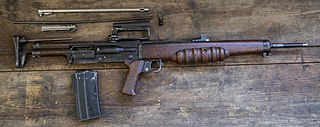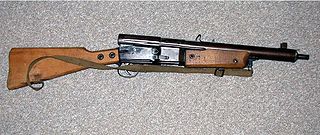
The StG 44 is a German assault rifle developed during World War II by Hugo Schmeisser. It is also known by its early designations as the MP 43 and MP 44. The StG 44 was an improvement of an earlier design, the Maschinenkarabiner 42(H).

The Gewehr 43 or Karabiner 43 is a 7.92×57mm Mauser caliber semi-automatic rifle developed by Germany during World War II. The design was based on that of the earlier G41(W) but incorporated an improved short-stroke piston gas system similar to that of the Soviet SVT-40.

An automatic rifle is a type of autoloading rifle that is capable of fully automatic fire. Automatic rifles are generally select-fire weapons capable of firing in semi-automatic and automatic firing modes. Automatic rifles are distinguished from semi-automatic rifles in their ability to fire more than one shot in succession once the trigger is pulled. Most automatic rifles are further subcategorized as battle rifles or assault rifles.

The EM-2, also known as Rifle, No.9, Mk.1 or Janson rifle, was a British assault rifle. It was briefly adopted by British forces in 1951, but the decision was overturned very shortly thereafter by Winston Churchill's incoming government in an effort to secure NATO standardisation of small arms and ammunition. It was an innovative weapon with the compact bullpup layout, built-in carrying handle and an optical sight.
Hugo Schmeisser was a German developer of 20th century infantry weapons.
The Fedorov Avtomat or FA is a select-fire infantry rifle and one of the world's first operational automatic rifles, designed by Vladimir Grigoryevich Fyodorov in 1915 and produced in the Russian Empire and later in the Russian Soviet Federative Socialist Republic. A total of 3,200 Fedorov rifles were manufactured between 1915 and 1925 in the city of Kovrov; the vast majority of them were made after 1920. The weapon saw limited combat in World War I, but was used more substantially in the Russian Civil War and in the Winter War. Some consider it to be an early predecessor or ancestor of the modern assault rifle.

A service rifle or standard-issue rifle is a rifle a military issues to its personnel, typically to its regular infantry. In modern militaries, this is generally a versatile and rugged assault rifle or battle rifle, suitable for use in nearly all environments and effective in most combat situations. Almost all modern militaries are issued service pistols as sidearms to accompany their service rifles. The term can also be used to describe weapons issued by non-military forces, such as law enforcement or paramilitaries.

The Volkssturmgewehr is the name of several rifle designs developed by Nazi Germany during the last months of World War II. They share the common characteristic of being greatly simplified as an attempt to cope with severe lack of resources and industrial capacity in Germany during the final period of the war. The Volkspistole was a partner program, almost identical, but for pistols instead.

An intermediate cartridge is a rifle/carbine cartridge that has significantly greater power than a pistol cartridge but still has a reduced muzzle energy compared to fully powered cartridges, and therefore is regarded as being "intermediate" between traditional rifle and handgun cartridges.
The StG 45(M) (abbreviation of Sturmgewehr 45, "Assault Rifle 45") sometimes referred to as the MP 45(M), was a prototype assault rifle developed by Mauser for the Wehrmacht at the end of World War II, using an innovative roller-delayed blowback operating system. It fired the 7.92×33mm Kurz (or "Pistolenpatrone 7.9mm") intermediate cartridge at a cyclic rate of around 450 rounds per minute.
The evolution of German military rifles is a history of common and diverse paths followed by the separate German states, until the mid-19th century when Prussia emerged as the dominant state within Germany and the nation was unified. This article discusses rifled shoulder arms developed in or for the military of the states that later became Germany; it excludes firearms of the Austrian Empire, except where they were used substantially by German troops.
The Sturmgewehr 52 (STG-52) was a battle rifle manufactured by the government-owned W+F Bern of Switzerland. It was chambered in the 7.5mm Kurzpatrone cartridge and later the 7.5mm Swiss service round as the Sturmgewehr 54, which was fed from the left-hand side. The Sturmgewehr 52 was heavily patterned after the German FG 42 as it was fed from the side from a 30- or 40-round magazine and was also fitted with a muzzle attachment capable of launching rifle grenades.

An assault rifle is a select fire rifle that uses an intermediate-rifle cartridge and a detachable magazine. Assault rifles were first put into mass production and accepted into widespread service during World War II. The first assault rifle to see major usage was the German StG 44, a development of the earlier Mkb 42. While immediately after World War II, NATO countries were equipped with battle rifles, the development of the M16 rifle during the Vietnam War prompted the adoption of assault rifles by the rest of NATO. By the end of the 20th century, assault rifles had become the standard weapon in most of the world's armies, replacing full-powered rifles and submachine guns in most roles. The two most successful modern assault rifles are the AK-47 and the M16 designs and their derivatives.

A rifle cartridge is a firearm cartridge primarily designed and intended for use in a rifle/carbine, or machine gun.

The 7.92×33mm Kurz is a rimless bottlenecked intermediate rifle cartridge developed in Nazi Germany prior to and during World War II, specifically intended for development of the Sturmgewehr 44. The ammunition is also referred to as 7.9mm Kurz, 7.9 Kurz, 7.9mmK, or 8×33 Polte. The round was developed as a compromise between the longer 7.92×57mm full-power rifle cartridge and the 9×19mm Parabellum pistol cartridge, and is the first mass-used intermediate cartridge in the world.

The 7.62×39mm round is a rimless bottlenecked intermediate cartridge of Soviet origin. The cartridge is widely used due to the worldwide proliferation of Russian SKS and AK-47 pattern rifles, as well as RPD and RPK light machine guns.

Grossfuss Sturmgewehr was a prototype assault rifle designed during World War II by Kurt Horn at the Grossfuss company better known for their contribution to the German arsenal made with the MG 42.

The Maschinenkarabiner 42(H) or MKb 42(H) (machine carbine Model 1942 (Haenel)) was an early German assault rifle firing an intermediate round of World War II. Designed in 1940 – 1941 by Hugo Schmeisser working for C. G. Haenel Waffen und Fahrradfabrik, several thousand were made and the gun was used on the Eastern Front in 1943.

The Maschinenkarabiner 42(W) (German: "machine carbine model 1942 (Walther)" ) or MKb 42(W) was an early German assault rifle designed in 1940-41 by Walther during World War II. The Mkb 42(W), and the more successful Maschinenkarabiner 42(H) designed by Haenel, were predecessors of the Sturmgewehr 44 (StG 44) assault rifle.
C.G. Haenel is a German weapon manufacturer located in Suhl, Germany.













